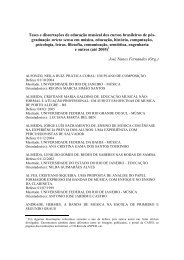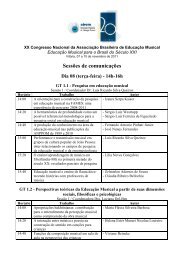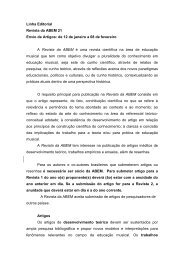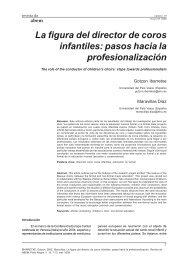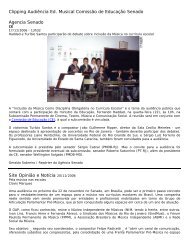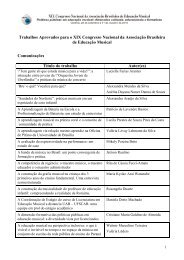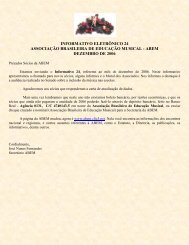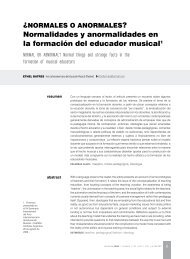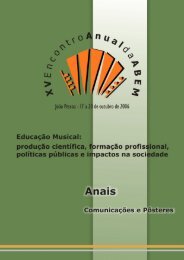artigo em pdf - ABEM
artigo em pdf - ABEM
artigo em pdf - ABEM
You also want an ePaper? Increase the reach of your titles
YUMPU automatically turns print PDFs into web optimized ePapers that Google loves.
número 12<br />
março de 2005<br />
revista da<br />
ab<strong>em</strong><br />
DUKE, R. A.; PRICKETT, C.A.; JELLISON, J. A. Empirical description of the pace of music instruction. Trabalho apresentado por<br />
ocasião do XII Simpósio de Pesquisa sobre Comportamento Musical. San Antonio, TX, 1997.<br />
JAQUES-DALCROZE, E. Rhythm, music and education. London: The Dalcroze Society, 1967.<br />
ELBAZ, F. Teacher thinking: a study of practical knowledge. Beckenham: Ken Nicholas Publishing, 1983.<br />
EPANCHIN, B. C. Constructive classroom manag<strong>em</strong>ent: strategies for creative positive learning environments Pacific Grove, CA:<br />
Brooks: Cole Pub. Co, 1994.<br />
GOOTMAN, M. E. The caring teacher’s guide to discipline: helping young students learn self-control, responsibility, and respect.<br />
Thousand Oaks, CA: Corwin Press, 1997.<br />
HUIZINGA, J. Homo ludens. Chicago: University of Chicago Press, 1955.<br />
JONES, V. F. Comprehensive classroom manag<strong>em</strong>ent: creating communities of support and solving probl<strong>em</strong>s. Boston: Allyn and<br />
Bacon, 1998.<br />
KAMEENUI, E. J. Instructional classroom manag<strong>em</strong>ent: a proactive approach to behavior manag<strong>em</strong>ent. White Plains, NY: Longman,<br />
1995.<br />
KERR, M. M. Strategies for managing behavior probl<strong>em</strong>s in the classroom. Upper Saddle River, NJ: Merrill, 1998.<br />
McGILL UNIVERSITY. Survey of teacher education programs: study documents and evaluation of the Faculty of Education. Montréal,<br />
1994.<br />
MERRIAM, S. B. Case study research in education: a qualitative approach. San Francisco: Jossey-Bass, 1988.<br />
MERRION, Margaret. How master teachers handle discipline. Music Educators Journal, Reston, v. 77, n. 2, p. 26-29, 1990.<br />
______. Classroom manag<strong>em</strong>ent for beginning music educators. In: SPRUCE, Gary (Ed.). Teaching music. London: Routledge: Open<br />
University, 1996. p. 43-67.<br />
NELSEN, J. Positive discipline in the classroom. Rocklin, CA: Prima Publishers, 1997.<br />
PALMER, P. The courage to teach: exploring the inner landscape of a teacher’s life. San Francisco: Jossey-Bass, 1990.<br />
PARTIN, R. L. Classroom teacher’s survival guide: practical strategies, manag<strong>em</strong>ent techniques, and reproducibles for new and<br />
experienced teachers. West Nyack, NY: Center for Applied Research in Education, 1995.<br />
RANALLO, J. Student conduct manag<strong>em</strong>ent: the passionate side of teaching. Vancouver: EduServ Education Library, 1997.<br />
RINNE, C. H. Excellent classroom manag<strong>em</strong>ent. London: Wadsworth Pub. Co, 1997.<br />
ROSENSTRAUCH, H. Essays on rhythm, music, mov<strong>em</strong>ent. Pittsburgh, PA: Volkwein Bros., Inc, 1993.<br />
RUSSELL, J. An investigation of the role of language in student conductors’ comprehension and construction of musical meanings in<br />
practicum settings. Tese de doutorado não-publicada. McGill University, 1995.<br />
______. Contexts of music classroom manag<strong>em</strong>ent. Arts and Learning Research Journal, Seattle, v. 16, n. 1, p. 197-225, 1999/2000.<br />
RUSSELL, M. T. Beating boredom, creating interest. Bloomington, Ind.: Phi Delta Kappa Educational Foundation, 1997.<br />
RYLE, G. The concept of mind. London: Penguin Books, 1949.<br />
SCARLETT, W. G. Trouble in the classroom: managing the behavior probl<strong>em</strong>s of young children. San Franciso: Jossey-Bass<br />
Publishers, 1998.<br />
SHAPIRO, E. S. Behavior change in the classroom: self-manag<strong>em</strong>ent interventions. New York: Guilford Press, 1994.<br />
SHORT, P. M. Rethinking student discipline: alternatives that work. Thousand Oaks, Calif.: Corwin Press, 1994.<br />
TAUBER, R. T. Classroom manag<strong>em</strong>ent: theory and practice. Fort Worth: Harcourt Brace College Publishers, 1995.<br />
VYGOTSKY, L. V. Thought and language. Tradução E. Hanfmann e G. Vakar. Cambridge: MIT Press, 1962.<br />
______. Mind in society: the development of higher psychological processes. Michael Cole, Vera John-Steiner, Sylvia Scribner e<br />
Ellen Souberman (Ed.). Cambridge, Massachusetts: Harvard University Press, 1978.<br />
WALKER, D. Teaching music: managing the successful music program. New York: Schirmer Books, 1998.<br />
WEINSTEIN, C.; MIGANO, A. El<strong>em</strong>entary classroom manag<strong>em</strong>ent: lessons from research and practice. New York: McGraw-Hill,<br />
1997.<br />
WILEY, J. Understanding and managing children’s classroom behavior. New York: Sam Goldstein, 1995.<br />
WOLCOTT, H. Posturing in qualitative inquiry: In: LECOMPTE, Margaret; MILLROY, Wendy; PREISSLE, Judith (Ed.). The handbook of<br />
qualitative research in education. San Diego: Acad<strong>em</strong>ic Press, 1992. p. 115-139.<br />
ZEIGER, A. 10 Steps to a happier classroom. Teaching Music, Reston, v. 4, n. 1, p. 38-39, 1996.<br />
ZIRPOLI, T. J. Behavior manag<strong>em</strong>ent: applications for teachers and parents. Upper Saddle River, N. J.: Merrill, 1993.<br />
Recebido <strong>em</strong> 29/12/2004<br />
Aprovado <strong>em</strong> 27/01/2005<br />
88




